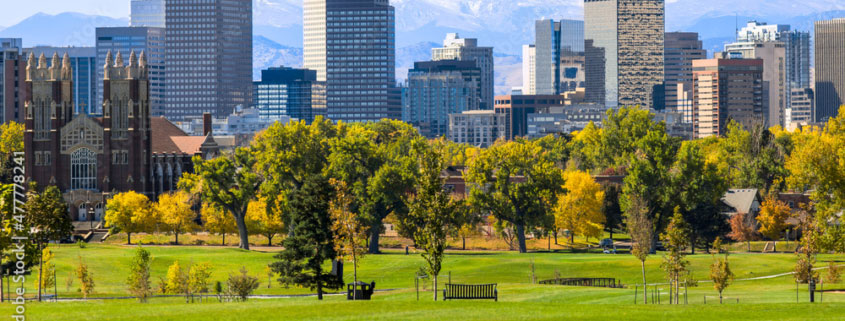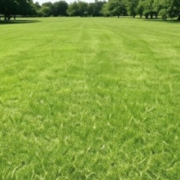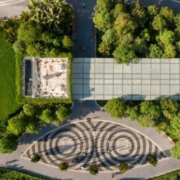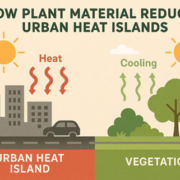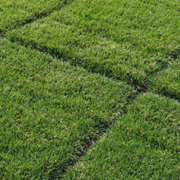Nature is Our Neighbor
Parks, green spaces, and urban landscapes are not just pretty or pleasing to the eye, they are vital to health and community well-being. We know, for example, that people living near green spaces have a 55% lower risk of developing psychiatric disorders like stress, anxiety, and substance abuse (Mulhern, 2020). Urban parks also help the environment by removing up to 711,000 tons of air pollutants every year. Additionally, parks also provide an estimated economic benefit of $3.8 billion to cities (City Parks Alliance, 2025). Supporting and expanding these spaces is essential for healthier and more livable communities and their benefits demonstrate that nature is, indeed, our neighbor and a great one at that!
How do Green Spaces Benefit Communities?
Research Highlights
- The environmental benefits of green spaces include urban heat islands mitigation, air and water quality improvements, and increased biodiversity and habitats.
- The economic value of green spaces includes increased property values and profitability for local businesses.
- Green spaces are also associated with improved community trust and crime reduction.
Green spaces benefit communities in many, many ways and these can be summarized in terms of environmental benefits, physical and mental health benefits, social benefits, and economic value. The environmental benefits of green spaces include mitigation of urban heat island (UHI) impacts, air and water quality improvements, and increased biodiversity and habitats. The physical and mental health benefits of green spaces include reduced stress and anxiety and increased physical activity. The social benefits of green spaces include reductions in crime as well as opportunities for public gathering, educational, and cultural engagement. The economic value of green spaces is also notable and includes increased property values, reduced infrastructure costs, and increased profitability for local businesses. Let’s take a deeper dive into these benefits to learn more.
Environmental Benefits
One of the many environmental benefits of green spaces is mitigation of the impacts of UHIs. Urban heat islands occur because of the density of impervious surfaces (think asphalt and concrete) in urban areas and their absorption and retention of heat. Summers in the U.S. have been warming since 1970 and UHIs worsen this warming and can also lead to serious health impacts, especially during the hottest parts of the year (Kenward et al., 2014).
Urban Heat Island
Trees, other landscape plants, and green spaces reduce local temperatures through shading and the processes of evaporation and transpiration, also known as evapotranspiration (ET). The leaves of trees and taller plants “catch” the radiation coming into the atmosphere from the sun and bounce it back out to cool green spaces. Shading from these plants also prevents incoming solar radiation from reaching the ground, contributing to cooling. All landscape plants also help cool the environment through the process of ET. This process has nothing to do with a small alien from outer space. ☺ It describes two of the processes by which moisture moves into the atmosphere from landscape plants. Evaporation of moisture from the soil and other surfaces increases the amount of water vapor in the air which cools by taking heat from the surrounding atmosphere. Transpiration also cools the environment in a similar way by moving water vapor through small openings in leaves known as stomata. As water vapor “leaves leaves”, it evaporates into the atmosphere which creates cooling by taking heat from the surrounding air. It’s similar to the way that perspiration cools the human body.
Air Quality
Trees, other landscape plants, and green spaces also improve air quality. They act as a natural air filter absorbing pollutants like ozone, nitrogen dioxide, ammonia, and particulate matter (PM₁₀, PM₂.₅). Plants capture these pollutants on leaf surfaces and then take them in through the same small openings (stomata) that release water vapor through the process of transpiration, reducing their concentration in the atmosphere. The shading and ET mentioned above also help air quality by reducing the formation of ground-level ozone (Nowak, 2010). Trees, other landscape plants, and green spaces also absorb carbon dioxide (CO2), a major greenhouse gas, through the process of photosynthesis. Sequestering this carbon in plant tissues and the associated soils helps mitigate the impacts of climate change (Natural Resources Defense Council, 2025).
Water Quality
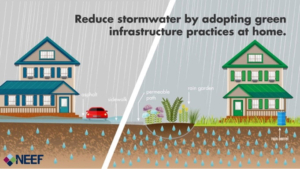
Trees, other landscape plants, and green spaces also improve water quality. They capture rainfall, reducing the volume and speed of stormwater runoff. This slows stormwater down and allows it to infiltrate soils, decreasing the strain on urban stormwater systems and minimizing flood risks. To learn more from the National Environmental Education Foundation read this article on How Landscaping Choices Affect Water Quality.
The root systems and soils associated with green spaces also act as natural filters that capture and break down pollutants like heavy metals, oils, and excessive amounts of nutrients before they can reach water bodies. This helps to protect the quality of surface and groundwater (Ross, 2024). Another way in which green spaces help to protect water quality is that root systems prevent the soil erosion which can lead to sedimentation in waterways. Reducing this sedimentation helps maintain both water clarity and water quality (Dahanayake et al., 2024).
Biodiversity and Habitat
Trees, other landscape plants, and green spaces play a pivotal role in enhancing biodiversity and providing essential habitats in urban environments. These natural areas offer refuge and resources for many species and contribute significantly to urban ecological health. When the plants in green spaces are diverse, habitat is created for many different species of birds, insects, and small mammals. Incorporating native plants and maintaining understory vegetation in green spaces has also been shown to increase biodiversity and demonstrates the importance of diverse plant structures in supporting urban biodiversity (Threlfall et al., 2017).
The size and quality of green spaces is also important and directly influences the diversity of bird and other wildlife species because larger green spaces attract more biodiversity and provide more shelter and resources for different species (La Sorte et al., 2020). The maintenance practices of urban green spaces are also important to biodiversity and habitat quality, and these can be tailored to promote biodiversity so that habitat quality and species richness are maintained (Hu and Lima, 2024).
Physical and Mental Health Benefits
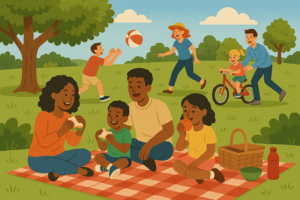 Trees, other landscape plants, and green spaces do more than make our communities beautiful. They play a vital role in promoting both mental and physical health and there is growing body of scientific literature that shows spending time in nature helps reduce stress, anxiety, and depression. Pioneering research by Ulrich (1984) demonstrated that even passive exposure to views of nature accelerated recovery from surgery and reduced stress. More recent studies have shown that two-hour weekly exposure to green spaces is associated with much better reports of health and psychological well-being (White et al., 2019). Nature-based therapies have also been linked to improved attention span and enhanced emotional regulation (Bratman et al., 2019). In addition to mental health, green spaces support physical well-being. Parks and trails promote active lifestyles which help to reduce obesity, cardiovascular disease, and type 2 diabetes (Maas et al., 2006). And as stated above, vegetation improves air quality by filtering pollutants like particulate matter (PM₁₀, PM₂.₅) and nitrogen dioxide, which are linked to respiratory illnesses. Studies have also shown that urban trees and grasses reduce asthma triggers by intercepting airborne particulates and absorbing gaseous pollutants (Nowak et al., 2006).
Trees, other landscape plants, and green spaces do more than make our communities beautiful. They play a vital role in promoting both mental and physical health and there is growing body of scientific literature that shows spending time in nature helps reduce stress, anxiety, and depression. Pioneering research by Ulrich (1984) demonstrated that even passive exposure to views of nature accelerated recovery from surgery and reduced stress. More recent studies have shown that two-hour weekly exposure to green spaces is associated with much better reports of health and psychological well-being (White et al., 2019). Nature-based therapies have also been linked to improved attention span and enhanced emotional regulation (Bratman et al., 2019). In addition to mental health, green spaces support physical well-being. Parks and trails promote active lifestyles which help to reduce obesity, cardiovascular disease, and type 2 diabetes (Maas et al., 2006). And as stated above, vegetation improves air quality by filtering pollutants like particulate matter (PM₁₀, PM₂.₅) and nitrogen dioxide, which are linked to respiratory illnesses. Studies have also shown that urban trees and grasses reduce asthma triggers by intercepting airborne particulates and absorbing gaseous pollutants (Nowak et al., 2006).
Social Benefits
Urban green spaces serve as dynamic hubs for social connection, inclusion, and community well-being. They are (generally) free and accessible gathering places for people of all ages, cultures, and socioeconomic backgrounds that promote social interaction, opportunities to play and relax, and they also help foster a sense of place and belonging (Peters et al., 2010). Approaches to green space design that incorporate inclusive green infrastructure also support social equity by offering a safe and welcoming space that can help bridge community divides.
Green spaces are also associated with improved community trust and crime reduction. In fact, studies have shown that well-maintained parks and tree-lined streets are linked to lower rates of property crime (Kuo and Sullivan, 2001). Green spaces also foster informal surveillance, increase foot traffic, and offer positive alternatives for youth, all of which contribute to enhanced perceptions of safety and cohesion. Additionally, green spaces support educational and cultural engagement. For example, community gardens and outdoor classrooms provide hands-on learning opportunities for communities. They also serve as locations for cultural festivals, public art installations, and performances, which enhances the social benefits to communities (Soga et al., 2016). These findings illustrate that green spaces are not only environmental assets, but also critical social infrastructure. Their presence strengthens neighborhood ties, promotes equity and inclusion, and fosters a more vibrant and resilient community life.
Economic Benefits
Along with the environmental and social benefits of green spaces, there are measurable economic benefits. One of the most documented of these is the increase in property values near parks and green spaces. Studies have shown, for example, that homes located within walking distance of a well-maintained park realize property value increases of 5 to 20% (Crompton, 2005). This is not only beneficial to homeowners but can also generate higher property tax revenues for communities.
In addition, green spaces help reduce public infrastructure costs, especially those related to stormwater management. Vegetation absorbs rainfall, reducing runoff volumes and the associated stress on urban drainage systems. This lessens the need for infrastructure upgrades and minimizes the potential for flood damage (U.S. Environmental Protection Agency, 2020).
Green spaces also contribute to local economies by increasing foot traffic and attracting customers to local businesses. Shaded sidewalks, pocket parks, and tree-lined commercial corridors offer more pleasant shopping and dining experiences while also encouraging longer visits and increased spending (Wolf, 2005).
Conclusion
Green spaces are far more than pretty spaces in our communities—they are essential infrastructure that supports environmental health, public well-being, social cohesion, and economic growth. From a scientific standpoint, green spaces help reduce urban heat through shading and evapotranspiration, improve air quality by filtering pollutants and sequestering carbon, and enhance water quality by managing stormwater and preventing erosion. They also support biodiversity, providing critical habitat for birds, insects, and small mammals, especially when designed to include native and diverse plant species. In these ways, green spaces can significantly improve the richness of urban ecosystems and contribute to long-term climate resilience.
In addition to these benefits, green spaces promote physical and mental health by encouraging active lifestyles and reducing stress, anxiety, and depression. They foster social well-being by offering inclusive and free public spaces that strengthen community ties, reduce crime, and support educational opportunities and cultural engagement. Economically, green spaces raise nearby property values, reduce infrastructure costs, and support local businesses by increasing foot traffic and making commercial areas more appealing. Altogether, these findings affirm that nature is more than a neighbor—it’s a necessary partner in creating healthy, equitable, and livable communities.
References
Bratman, G.N., C.B. Anderson, M.G. Berman, B. Cochran, S. de Vries, J. Flanders, C. Folke, H. Frunkin, J.J. Gross, T. Hartig, P.H. Kahn Jr., M. Kuo, J.J. Lawler, P.S. Levin, T. Lindahl, A. Meyer-Lindenberg, R. Mitchell, Z. Ouyang, J. Roe, L. Scarlett, J.R. Snith, M. Van Den Bosch, B.W. Wheeler, M.P. White, H. Zheng, and G.C. Daily. 2019. Nature and mental health: An ecosystem service perspective. Science Advances 5(7), eaax0903.
City Parks Alliance. Why city parks matter. Retrieved March 30, 2025. https://cityparksalliance.org/about-us/why-city-parks-matter/.
Crompton, J.L. 2005. The impact of parks on property values: A review of the empirical evidence. Journal of Leisure Research 33(1):1-31.
Dahanayake, A.C., J.A. Webb and J. Greet. 2024. How do plants reduce erosion? An Eco Evidence assessment. Plant Ecology 225:593–604.
Hu, X. and M.F. Lima. 2024. The association between maintenance and biodiversity in urban green spaces: A review. Landscape and Urban Planning 251: 10513.
Kenward, A., D. Yawitz, T. Sanford and R. Wang. 2014. Summer in the City: Hot and Getting Hotter. Climate Central. Princeton, NJ.
Kuo, F.E. and W.C. Sullivan. 2001. Environment and crime in the inner city: Does vegetation reduce crime? Environment and Behavior 33(3):343-367.
La Sorte, F.A., M.F.J. Aronson, C.A. Lepczyk and K.G. Horton. 2020. Area is the primary correlate of annual and seasonal patterns of avian species richness in urban green spaces. Landscape and Urban Planning 203:103892.
Maas, J., R.A. Verheij, P.P. Groenewegen, S. de Vries and P. Spreeuwenberg. 2006. Green space, urbanity, and health: how strong is the relation? Journal of Epidemiology & Community Health 60(7):587-592.
Mulhern, O. 2020. Data proves the health benefits of green spaces. Earth.Org. https://earth.org/data_visualization/data-proves-the-health-benefits-of-green-spaces/.
Natural Resources Defense Council. Green infrastructure: How to manage water in a sustainable way. Retrieved March 30, 2025, from https://www.nrdc.org/stories/green-infrastructure-how-manage-water-sustainable-way
Nowak, D. J., D.E. Crane and J.C. Stevens. 2006. Air pollution removal by urban trees and shrubs in the United States. Urban Forestry & Urban Greening 4(3-4):115-123.
Nowak, D. J., & Heisler, G. M. 2010. Air quality effects of urban trees and parks. National Recreation and Park Association. Retrieved from https://www.nrpa.org/globalassets/research/nowak-heisler-research-paper.pdf.
Peters, K., B. Elands and A. Buijs. 2010. Social interactions in urban parks: Stimulating social cohesion? Urban Forestry & Urban Greening 9(2):93-100.
Ross, L. 2024. How landscaping choices affect water quality. National Environmental Education Foundation. https://www.neefusa.org/story/water/how-landscaping-choices-affect-water-quality.
Soga, M., K.J. Gaston, Y. Yamaura, K. Kurisu and K. Hanaki. 2016. Both direct and vicarious experiences of nature affect children’s willingness to conserve biodiversity. International Journal of Environmental Research and Public Health 13(6):529.
Threlfall, C.G., L. Mata, J.A. Mackie, A.K Hahs, N.E. Stork, N.S.G. Williams, S.J. Livesley. 2017. Increasing biodiversity in urban green spaces through simple vegetation interventions. Journal of Applied Ecology 54(6)1874-1883.
Ulrich, R. S. 1984. View through a window may influence recovery from surgery. Science 224 (4647):420-421. https://doi.org/10.1126/science.6143402.
U.S. Environmental Protection Agency. 2020. Using green infrastructure to reduce heat islands. https://www.epa.gov/heatislands/using-green-infrastructure-reduce-heat-islands.
White, M. P., I. Alcock, J. Grellier, B.W. Wheeler, T. Hartig, S.L. Warber, A. Bone, M.H. Depledge, and L.E. Fleming. 2019. Spending at least 120 minutes a week in nature is associated with good health and wellbeing. Scientific Reports 9(1):7730. https://doi.org/10.1038/s41598-019-44097-3.
Wolf, K.L. 2005. Business district streetscapes, trees and consumer response. Journal of Forestry 103(8):396-400.
Yale Environment 360. 2014. Summer temperatures in U.S. have risen up to 5 degrees since 1970. Yale School of the Environment https://e360.yale.edu/digest/summer_temperatures_in_us_have_risen_up_to_5_degrees_since_1970

